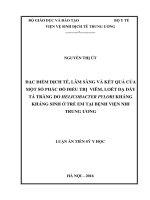SLIDE Viêm dạ dày, nhiễm vi khuẩn Helicobacter pylori
Bạn đang xem bản rút gọn của tài liệu. Xem và tải ngay bản đầy đủ của tài liệu tại đây (7.1 MB, 23 trang )
NHÂN MỘT TRƯỜNG HỢP
Viêm dạ dày, nhiễm vi khuẩn
Helicobacter pylori
Bs. Lê Đình Tín
Phòng Khám Tiêu Hóa – Gan Mật
Bàn luận
Ngày
18/10/2012
Triệu chứng
- Buồn nôn, nóng ruột,
quặn bụng
Xét nghiệm
HP test IgG và IgM:
NEG
- Đau thượng vị âm ỉ.
24/8/2017
- Đã được điều trị HP ở
Bv ĐHYD, muốn được
kiểm tra.
Nhận định
Không nhiễm HP.
Không nhiễm HP, khả năng:
HP breath test: NEG
-Nhiễm HP đã điều trị hết
-Âm tính giả.
Nhiễm HP, khả năng:
24/12/2018
- Đau hông phải, khó
chịu vùng thượng vị
HP breath test: POS
-Tái phát hay Tái nhiễm.
-Dương tính giả (ít).
False-negative results
…There is firm evidence to implicate that recent use of proton pump inhibitors (PPI)
(within 2 weeks) or antimicrobials (within 4 weeks) may lead to a decrease in the gastric
bacterial load causing falsenegative results. Bleeding can also reduce the sensitivity of
both UBT and SAT. Data from a systematic review suggests repeating diagnostic tests in
patients with bleeding ulcer after at least 4 weeks in case of a negative result. In patients
with precancerous conditions (e.g. atrophic gastritis, intestinal metaplasia) or gastric
cancer, as well as in patients with partial gastrectomy, diagnostic tests may have lower
accuracy.
False-positive results
…Apart from false-negative results listed above, UBT also gives false-positive results,
which have received more attention during the past 10 years. These false-positive results
are typical to patients with acid-free stomach (due to AG or a long term use of PPIs),
where urease-positive bacterial species or yeast-like organisms colonize.
/>
Bàn luận
Successful eradication of H. pylori is defined as negative H. pylori status in a
previously H. pylori‐infected patient at least 4 weeks after treatment. Recurrence is defined
as evidence of an active H. pylori infection in a patient with previously confirmed H. pylori
eradication. Recurrence can occur either by recrudescence or reinfection.
-Recrudescence is defined as reappearance of the original infection that was
temporarily suppressed leading to false results tests regarding eradication.
-Reinfection is defined as infection with a new strain of H. pylori or recurrence of
infection after an as yet undefined period (eg, 6 months to 2 years).
/>
Recrudescence reflects the reappearance of the originnal strain of H. pylori following
its temporary suppression rather than successful eradication. Instead, true reinfection
occurs when, after successful eradication, a patient becomes infected with either the original
strain or a new strain of H. pylori.
/>
…Recurrence of H pylori after eradication is rare in developed countries and more
frequent in developing countries. The proportion of H pylori annual recurrence was 2.67%
and 13.00% in developed and developing countries, respectively.
…A different approach for follow-up after H pylori eradication is probably needed in
patients of developing countries, since reinfection is highly prevalent.
/>
Aim: To evaluate the global recurrence rate following H. pylori eradication therapy and
confirm its association with socioeconomic and sanitary conditions.
Methods: A systematic search of PubMed, EMBASE and the Cochrane library was
performed to identify potentially relevant publications using the following keywords:
“Helicobacter pylori” or “H. pylori” or “Hp” and “recurrence” or “recrudescence” or “reinfection”
or “recurrent” or “recurred” or “re‐infect*” or “relapse*.”
Results: A total of 132 studies (53 934 patient ‐years) were analysed.
-The global annual recurrence, reinfection and recrudescence rate of H. pylori were 4.3%
(95% CI, 4‐5), 3.1% (95% CI, 2‐5) and 2.2% (95% CI, 1 ‐3), respectively.
-The H. pylori recurrence rate was inversely related to the human development index (HDI)
(ie, 3.1% [95% CI, 2‐4], 6.2% [95% CI, 4‐8] and 10.9% [95% CI, 6 ‐18] in countries with a very
high, high and medium or low HDI) (P <.01)
-and directly related to H. pylori prevalence (10.9% [95% CI, 7 ‐16], 3.7% [95% CI, 3 ‐5], 3.4%
[95% CI, 2‐5] and 1.6% [95% CI, 0.5‐3] in countries with a very high, high, medium or low
local H. pylori prevalence) (P <.01).
-Global recurrence rates remained relatively stable between 1990s, 2000s and 2010s but
varied across different regions (P <.05).
/>
Helicobacter pylori, transmission routes and recurrence of
infection: state of the art
Stefano Kayali, Marco Manfredi, Federica Gaiani, Laura Bianchi, Barbara
Bizzarri, Gioacchino Leandro, Francesco di Mario, Gian Luigi de’Angelis
Many investigators have found that recurrence rates during the first 3-12 months after
cure are due to late recrudescence. A documented H. pylori negativity for 1 year after
treatment is a reliable indicator of successful eradication without recrudescence.
Recrudescence rather than reinfection is likely to be responsible for most recurrent
cases because the recurrences decrease with time, declining sharply after the first year,
and identified strains (before and after therapy) are usually genetically identical.
Intrafamilial transmission could be also involved in the reinfection of H. pylori. Genetic
factors may also play a role, susceptible individuals who have eradicated H. pylori may be
prone to reinfection when they are exposed to H. pylori-positive people
The high prevalence of H. pylori infection may possibly be associated with high
recurrence of infection after eradication because of the high risk of re-exposure.
/>
Bàn luận
Điều trị Tái phát và Tái nhiễm HP:
-Chưa được đề cập đến trong đồng thuận Maastrich V.
-Suy luận:
Tái phát (Recrudescence, Relapse): có thể xem như thất bại của lần điều trị
trước đó, cần thay đổi phác đồ điều trị với các thuốc kháng sinh chưa dùng
trước đó.
Tái nhiễm (Reinfection): có thể áp dụng các phác đồ như điều trị ban đầu. Có
thể xét đến việc điều trị nguồn lây nhiễm là những người thân trong gia đình.
-Thực tế: khó phân biệt chính xác Tái phát và Tái nhiễm vì thường không có xét nghiệm
“dấu ấn AND” của các chủng H pylori trước và sau khi điều trị, nên dùng kháng sinh
bệnh nhân chưa được dùng trước đó hay phác đồ 4 thuốc có Bismuth.
/>
Bàn luận
Trở lại bệnh nhân vừa trình bày:
•
Chẩn đoán: Viêm dạ dày, nhiễm vi khuẩn H pylori, nghi Tái nhiễm.
•
Điều trị:
Phác đồ 4 thuốc có Bismuth.
Xét đến yếu tố gia đình.
Kết luận
Tái phát hay Tái nhiễm sau khi điều trị tiệt khuẩn HP là vấn đề có thể gặp
trong thực hành hằng ngày, việc phân biệt chính xác giữa chúng còn khó
khăn và nhiều khi không có ý nghĩa thực tế.
Thu thập đầy đủ các thông tin về các lần điều trị trước đây như cách chẩn
đoán, các thuốc đã dùng và tiền căn gia đình,…sẽ giúp có hướng chẩn
đoán chính xác và chỉ định điều trị thích hợp.
Tài liệu tham khảo
/>
/>
/>007.pdf
/>
/>
/>
/>
/>
/>
/>7
CHÂN THÀNH CẢM ƠN SỰ CHÚ Ý CỦA QUÝ VỊ









